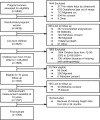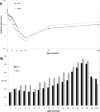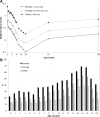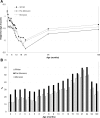Stunted at 10 Years. Linear Growth Trajectories and Stunting from Birth to Pre-Adolescence in a Rural Bangladeshi Cohort
- PMID: 26934484
- PMCID: PMC4775024
- DOI: 10.1371/journal.pone.0149700
Stunted at 10 Years. Linear Growth Trajectories and Stunting from Birth to Pre-Adolescence in a Rural Bangladeshi Cohort
Abstract
Background: Few studies in low-income settings analyse linear growth trajectories from foetal life to pre-adolescence. The aim of this study is to describe linear growth and stunting from birth to 10 years in rural Bangladesh and to analyse whether maternal and environmental determinants at conception are associated with linear growth throughout childhood and stunting at 10 years.
Methods and findings: Pregnant women participating in the MINIMat trial were identified in early pregnancy and a birth cohort (n = 1054) was followed with 19 growth measurements from birth to 10 years. Analyses of baseline predictors and mean height-for-age Z-scores (HAZ) over time were modelled using GLMM. Logistic regression analysis was used to investigate the associations between baseline predictors and stunting (HAZ<-2) at 10 years. HAZ decreased to 2 years, followed by an increase up to 10 years, while the average height-for-age difference in cm (HAD) to the WHO reference median continued to increase up to 10 years. Prevalence of stunting was highest at 2 years (50%) decreasing to 29% at 10 years. Maternal height, maternal educational level and season of conception were all independent predictors of HAZ from birth to pre-adolescence (p<0.001) and stunting at 10 years. The highest probability to be stunted at 10 years was for children born by short mothers (<147.5 cm) (ORadj 2.93, 95% CI: 2.06-4.20), mothers with no education (ORadj 1.74, 95% CI 1.17-2.81) or those conceived in the pre-monsoon season (ORadj 1.94, 95% CI 1.37-2.77).
Conclusions: Height growth trajectories and prevalence of stunting in pre-adolescence showed strong intergenerational associations, social differentials, and environmental influence from foetal life. Targeting women before and during pregnancy is needed for the prevention of impaired child growth.
Conflict of interest statement
Figures






Similar articles
-
Stunting, recovery from stunting and puberty development in the MINIMat cohort, Bangladesh.Acta Paediatr. 2020 Jan;109(1):122-133. doi: 10.1111/apa.14929. Epub 2019 Aug 1. Acta Paediatr. 2020. PMID: 31283046 Clinical Trial.
-
Stunting at birth: recognition of early-life linear growth failure in the western highlands of Guatemala.Public Health Nutr. 2015 Jul;18(10):1737-45. doi: 10.1017/S136898001400264X. Public Health Nutr. 2015. PMID: 26017476 Free PMC article.
-
Trends and long-term variation explaining nutritional determinants of child linear growth: analysis of Bangladesh Demographic and Health Surveys 1996-2018.Public Health Nutr. 2023 Dec;26(12):2758-2770. doi: 10.1017/S1368980023002288. Epub 2023 Oct 27. Public Health Nutr. 2023. PMID: 37886806 Free PMC article.
-
Nutritional interventions for preventing stunting in children (birth to 59 months) living in urban slums in low- and middle-income countries (LMIC).Cochrane Database Syst Rev. 2019 Jun 17;6(6):CD011695. doi: 10.1002/14651858.CD011695.pub2. Cochrane Database Syst Rev. 2019. PMID: 31204795 Free PMC article.
-
Drivers of stunting reduction in Peru: a country case study.Am J Clin Nutr. 2020 Sep 14;112(Suppl 2):816S-829S. doi: 10.1093/ajcn/nqaa164. Am J Clin Nutr. 2020. PMID: 32860403 Free PMC article.
Cited by
-
The epidemiology of undernutrition and its determinants in children under five years in Ghana.PLoS One. 2019 Jul 31;14(7):e0219665. doi: 10.1371/journal.pone.0219665. eCollection 2019. PLoS One. 2019. PMID: 31365528 Free PMC article.
-
Characterisation and correlates of stunting among Malaysian children and adolescents aged 6-19 years.Glob Health Epidemiol Genom. 2019 Mar 4;4:e2. doi: 10.1017/gheg.2019.1. eCollection 2019. Glob Health Epidemiol Genom. 2019. PMID: 30891249 Free PMC article.
-
Child linear growth trajectories during the first three years of life in relation to infant iron status: a prospective cohort study in rural Vietnam.BMC Nutr. 2022 Feb 15;8(1):14. doi: 10.1186/s40795-022-00505-y. BMC Nutr. 2022. PMID: 35164876 Free PMC article.
-
Birth seasons and heights among girls and boys below 12 years of age: lasting effects and catch-up growth among native Amazonians in Bolivia.Ann Hum Biol. 2018 Jun;45(4):299-313. doi: 10.1080/03014460.2018.1490453. Ann Hum Biol. 2018. PMID: 30328382 Free PMC article.
-
Early-Life Cadmium Exposure and Bone-Related Biomarkers: A Longitudinal Study in Children.Environ Health Perspect. 2019 Mar;127(3):37003. doi: 10.1289/EHP3655. Environ Health Perspect. 2019. PMID: 30848671 Free PMC article.
References
-
- Black RE, Victora CG, Walker SP, Bhutta ZA. Maternal and child undernutrition and overweight in low-income and middle-income countries. The Lancet. 2013. - PubMed
-
- WHO Expert Committee on Physical Status. WHO Expert Comittee on Physical Status: The Use and Interpretation of Anthropometry. 1995 pp. 1–463. - PubMed
-
- Martorell R, Ramakrishnan U, Schroeder D, Melgar P, Neufeld L. Intrauterine growth retardation, body size, body composition and physical performance in adolescence. Eur J Clin Nutr. 1998;52 Suppl 1: S43–52; discussion S52–3. - PubMed
Publication types
MeSH terms
LinkOut - more resources
Full Text Sources
Other Literature Sources
Medical

